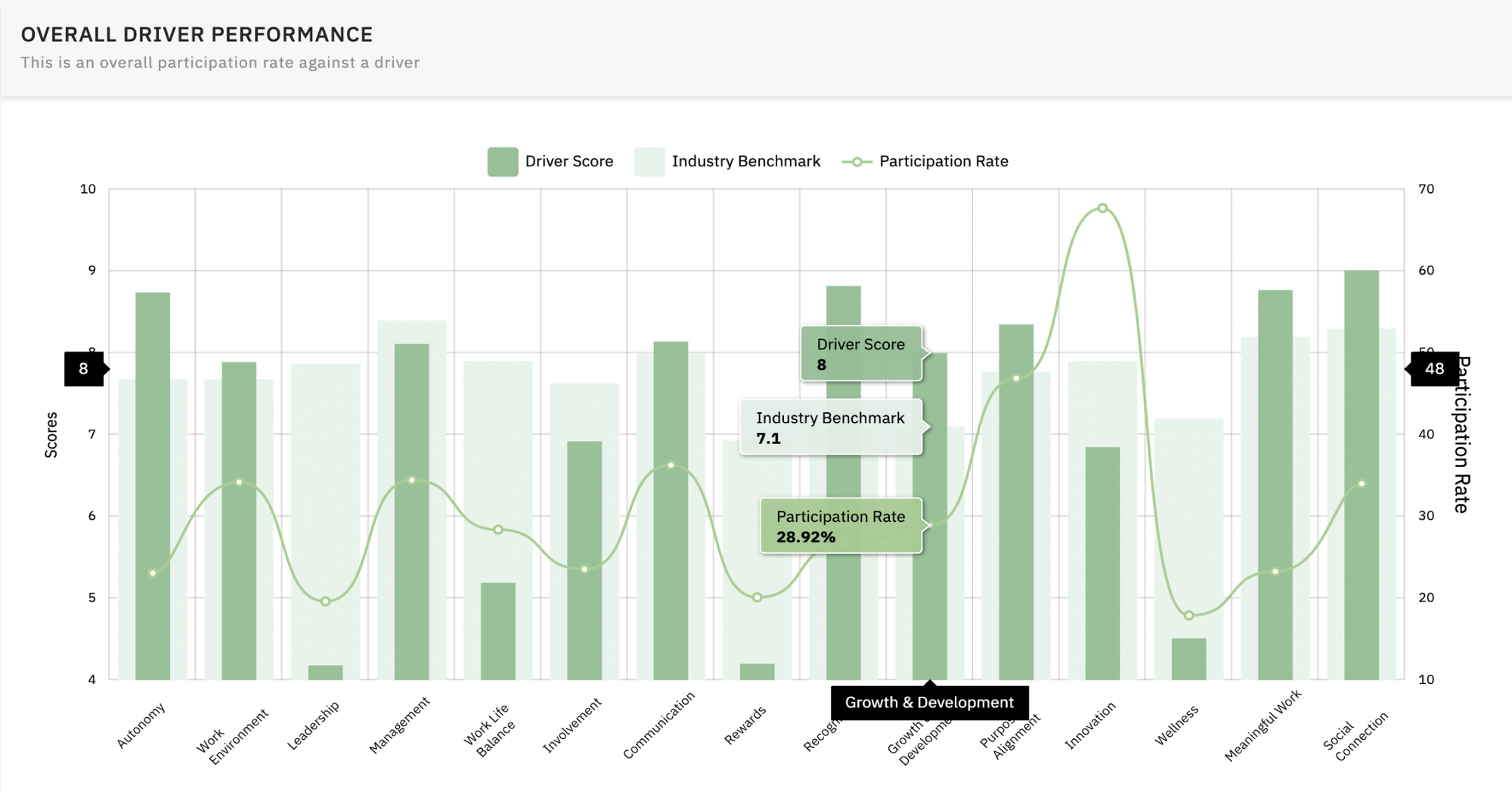The pandemic has led many organizations and employees to move and work remotely and paved the path for a remote and hybrid working style. This may have given employees more flexibility, but they also had to be more organized and self-motivated. In such a scenario, keeping up with employee engagement can be tricky.
It is almost impossible to measure employee engagement without understanding what motivates them to perform well at their jobs, especially with a remote or hybrid workforce. Employee engagement lies at the core of a growing business. However, measuring employee engagement is not as straightforward as you may think.
Understanding what are the drivers of employee engagement is essential to have better control over it. Even though there is no universal set of drivers of employee engagement, we have compiled some of the critical drivers of employee engagement that are effective for employees across industries as well as remote and hybrid employees.
Table of contents:
1) What is employee engagement?
2) Why is employee engagement important?
3) 15 key drivers of employee engagement in 2022
4) 7 tips to use for driving employee engagement within a remote and hybrid workforce
5) Conclusion
What is employee engagement?


Most people associate employee engagement with employee satisfaction. However, employee engagement goes beyond just being satisfied. An engaged employee will likely take the initiative, contribute ideas, share knowledge, and stay connected with colleagues and managers. These behaviors lead to increased productivity and higher-quality output.
Employee engagement can be defined as “the degree to which employees participate in their work and feel they have a positive impact on achieving organizational goals.” It is a critical factor in creating successful organizations as it helps drive productivity in employees and keep them motivated.
In today’s business environment, companies are looking at ways to improve employee engagement to scale their business. Organizations that focus on providing opportunities for employees to learn, grow and develop professionally are able to retain top talent and sustain high-performance levels using various drivers of employee engagement.
Why is employee engagement important?


Understanding the top drivers of employee engagement helps form strategies to improve overall work culture that can, in turn reduce employee turnover and increase employee satisfaction.
Hybrid and remote workplaces are becoming increasingly common as organizations strive to be more agile and responsive to the needs of their employees. As such, it is important to consider the relevance of the employee engagement drivers in these types of work environments.
There are a number of reasons why measuring different drivers of employee engagement is essential in hybrid and remote workplaces.
- These types of environments can be quite isolating for employees. Without regular face-to-face interaction with colleagues, employees can easily feel disengaged from their work. This can lead to absenteeism, low productivity, and high turnover rates.
- Hybrid and remote workplaces often require employees to be highly self-motivated and self-disciplined. This can be a challenge for some individuals, who may find it difficult to stay focused and on task without the structure of a traditional office environment. Engaged employees are more likely to be motivated and productive in these kinds of situations.
- Hybrid and remote workers often have a great deal of control over their own schedules and workloads. While this can be empowering for some, it can also be overwhelming or stressful for others. Employees who are engaged with their work are more likely to have the capacity to manage their time and workload effectively, resulting in better overall performance.
Drivers of employee engagement give you a bigger picture of how to measure employee engagement, what to measure, and the results you gain from employee engagement in hybrid and remote workplaces.
Measuring and analyzing your drivers of employee engagement can help identify areas where employees are disengaged and identify opportunities to improve engagement. Organizations can then use this to foster a culture of engagement that will reap numerous benefits in terms of higher productivity, satisfaction, and creativity.
15 key drivers of employee engagement in 2022
Here are the top 15 drivers of employee engagement in 2022:
1) Communication
Communication is one of the key drivers of employee engagement. By sharing information about the company’s goals and strategies, communicating regularly with employees, and providing feedback on performance, organizations, and managers can engage employees and help them feel connected to the organization. Effective communication can also help reduce employee turnover and improve morale.
2) Recognition
Recognizing and appreciating employees’ work is a critical driver of employee engagement that influences the relationship between the employee and the employer.
Employees who believe their work is valued by the firm and advances its long-term objectives are more engaged at work. Regularly demonstrating your appreciation for employees’ accomplishments is a little but meaningful gesture that helps them feel valued.
Furthermore, rewarding high-performing employees who deliver consistently and quality work can boost their morale. This reward can be in the form of a gift card, a free vacation, or as a bonus. This can also encourage and motivate other employees to do better and achieve more significant results for the organization.
3) Professional development
Organizational leaders have long recognized that professional development opportunities are key drivers of employee engagement. By offering employees opportunities to learn new skills, stay current in their field, and advance their careers, organizations demonstrate a commitment to their employees’ professional growth.
This commitment can pay off in the form of higher levels of employee engagement and motivation, which can, in turn lead to better organizational performance. This driver of employee engagement also encourages employees and teams to take advantage of the available resources and opportunities.
4) Empowerment
The empowerment of employees can be considered one of the most important drivers of employee engagement. Employee empowerment gives employees the needed authority and freedom to perform their work and to make necessary decisions to achieve the organization’s goals and objectives.
When employees feel like they have a say in what goes on in the workplace and they feel like their voices are heard, they are more likely to be engaged and productive.
5) Autonomy
Autonomy is one of the most powerful drivers of employee engagement that helps improve employee satisfaction. When employees feel that they have a high degree of control over their work, they are more likely to be engaged and feel a sense of ownership over their projects.
This sense of control and ownership can lead to increased motivation and productivity. When employees are provided with the control and freedom they need to perform well at their jobs, it increases their positive attitude toward work and the organization.
6) Purpose
A sense of purpose can also help to create a more positive work environment, as employees who feel that their work is meaningful are more likely to be cooperative and supportive of their colleagues.
Employees who feel that their work is connected to a larger purpose tend to be more engaged and motivated. Measuring this driver of employee engagement will give you a clear picture if your leadership communication on the company mission, vision, and long-term goals are aligned with your employees or not.
7) Work-life balance
Work-life balance is one of the most crucial drivers of employee engagement one needs to measure to improve their workplace engagement. Achieving a balance between work and life outside of work is another important one amongst the critical drivers of employee engagement.
There are a variety of ways that organizations can support employees in achieving work-life balance. Flexible work arrangements, such as telecommuting or flexible hours, can prove to do well if the employees work from the office.
In a hybrid or remote work mode, family-friendly benefits, quarterly time-offs, and health benefits such as gym memberships or free therapy and spa sessions are some ways to avoid burnout and ensure your employee’s after-work life is not interrupted by work.
8) Leadership
Leader availability and integrity are two critical aspects of employee engagement. Demonstrating the commitment the leadership of the organization has toward the company’s success creates a positive impact on employees.
Furthermore, measuring this driver of employee engagement will give you an idea if your employees look up to their managers and leaders for motivation and guidance or not. They should be dependable, reliable, and approachable by the employees so that they feel at ease when looking for support, which improves interpersonal trust.
9) Inclusivity
A supportive and inclusive community is one of the essential drivers of employee engagement in the post-pandemic world. Encouraging healthy differences in opinion can foster success in the workplace. How? This creates the path for a collaborative mindset amongst employees. Remote workplaces include employees of different ethnicities, backgrounds and experiences.
Recognizing and appreciating these differences is important to understand how your organization can move forward.
An inclusive and diverse community can help employees recognize their importance in the organization and how they can help achieve the goals and objectives in unity. At the same time, encourage an open and communicative environment to voice opinions and feedback. This way, you can learn about the crucial factors and take steps to improve engagement and build a better workplace.
10) Collaboration
Measuring collaboration as a driver of employee engagement in this post-pandemic era is really important. As, There is a strong correlation between collaboration and employee engagement. Employees sometimes need to work as a team rather than individually for certain projects and tasks. When employees feel like they can collaborate with their colleagues, teams, and organization effortlessly, they tend to feel valued.
Collaboration can lead to increased communication, creativity, and productivity and helps build trust and respect among employees.
11) Workplace relations
Positive relationships at the workplace are a good driver of employee engagement. This includes employee relations with the managers or superiors, co-workers, and the organization itself.
Engaged employees are more likely to advocate for their organization and to be satisfied with their job and will become positive promoters of your organization, reducing your hiring costs.
12) Work environment
This driver of employee engagement can either support or hinder an employee’s ability to do their job. Engagement will likely be high if the work environment is conducive to employee productivity.
However, employee engagement will suffer if the work environment is unsupportive or even hostile. Therefore, employers need to create a work environment that supports employee engagement.
13) Innovation
Taking the initiative can be a great driver for employee engagement. You can create a more dynamic and engaging work environment by encouraging employees to come up with new ideas and solutions. Additionally, providing them with opportunities to contribute can help to improve job satisfaction by providing employees with opportunities to use their creativity and skills.
14) Psychological safety
The most essential driver of employee engagement that one can’t skip measuring is the psychological safety at the workplace. When employees are able to be themselves and share their ideas, they are more likely to feel safe without fear of backlash. A safe environment allows employees to take risks, experiment, and learn from mistakes. This leads to a more innovative and productive workforce.
15) Positive Mental Health
Sound health does not just point to physical health. One of the most neglected and yet equally important part of every employee’s life is their mental health. Mental health can be affected by performance pressure, job insecurity, and poor relationships with managers or co-workers. Whatever the reason, poor mental health can affect an employee’s productivity and overall performance.
Providing employees with an Employee Assistance Program (EAP), time and space for employees to relax, and a survey for self-assessment on mental health with clinical screenings or free consultations with therapists can help.
Moreover, measuring employee wellness and well-being as a driver of employee engagement will help you analyze how you can help improve employee engagement by promoting a culture of positive mental and physical health within the organization.
7 tips to use for driving employee engagement within a remote and hybrid workforce


So far, we have understood several drivers of employee engagement, regardless of whether a workforce is remote or hybrid. But how can you ensure they are effective? We have come up with some tips and strategies that you can put to use to ensure maximum effectiveness from these drivers of employee engagement in your organization.
Conduct employee surveys


The most efficient way of measuring the drivers of employee engagement is through employee engagement surveys, as it provides a deeper-level understanding of each and every employee.
You can then use these surveys to develop a heatmap that displays scores based on several drivers of employee engagement in the organization. Here’s a sample employee engagement heatmap within the CultureMonkey platform that collects employee survey responses and records them as scores.
Provide ample opportunities for growth
Engagement should never be a one-time event. To truly engage employees, organizations must create opportunities for growth and development. This can be done through measuring your drivers of employee engagement regularly, having training and development programs, mentorship opportunities, and cross-functional projects.
By providing employees with opportunities to grow, you can create a culture of engagement that will inspire employees to stay with the company for the long haul.
Recognize talented and high-performing employees


Recognizing talented and high-performing employees is essential for any organization. All employees expect to be appreciated and recognized for the work they do. In order to motivate others who are unable to, it is essential to understand where they are lacking.
The drivers of employee engagement and employment scores can be used to analyze these specific areas of employee engagement. Take a look at this bar chart comparison drawn from the heatmap given in the first point.
It provides valuable insights for easy tracking, which can help track engagement and use it to measure employee performance.
Collect feedback and implement them
Collect employee feedback regularly through employee surveys, interviews, or focus groups. You can use them to identify which drivers of employee engagement are to be worked upon. Once identifying these specific drivers, implement the required changes to improve them.
Maintain transparency
Communicate openly and frequently with your employees and be clear about how decisions are made and why certain decisions are made. Focusing on the most important drivers of employee engagement can help them feel like they are a part of the decision-making process and that their voices are heard.
Give employees authority and responsibility
Giving employees authority and responsibility is key to empowering them to do their jobs effectively. When employees feel like they have a say in what goes on and are trusted to make decisions, they are more likely to be motivated to do their best work.
Allow free flow of communication
Encourage employees to communicate openly with one another and with management. Promote an environment where employees feel comfortable sharing their ideas, concerns, and feedback. Also, encourage employees to ask questions and ensure they feel comfortable doing so.
Conclusion
Companies need to be mindful of these fifteen critical drivers of employee engagement when it comes to driving employee engagement within a remote or hybrid workforce. Employees who feel like their work is purposeful and that they are appreciated will be more engaged than those who don’t.
Similarly, employees who have a good work/life balance will be more engaged than those who feel like they’re always on the clock. Lastly, effective communication is essential to keeping employees engaged; regular check-ins and open lines of communication will ensure that everyone feels included and valued.
